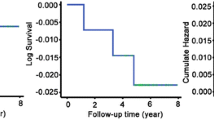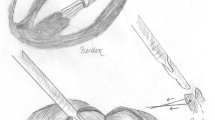Abstract
Purposes
To characterize the clinical features and surgical outcomes of symptomatic hypertrophic obstructive cardiomyopathy (HOCM) in patients with only mild septal hypertrophy.
Methods
The clinical characteristics and surgical outcomes of 53 HOCM patients with a basal septal thickness ≤ 16 mm (mild group) were compared with those of 128 HOCM patients with a basal septal thickness > 16 mm (control group).
Results
The mild group had a greater prevalence of mitral subvalvular anomalies than the control group (79.2% vs. 6.3%, p < 0.001). Neither iatrogenic septal perforation nor inadequate septal myectomy was observed after myectomy in the mild group. There were no deaths during a median follow-up of 10 months. Transthoracic echocardiography 6 months after myectomy revealed a significant decrease in maximum gradients in both groups, from baseline 90.5 ± 21.5 mmHg to 10.3 ± 4.4 mmHg in the mild group (p < 0.001) and from 95.0 ± 22.0 mmHg to 12.0 ± 5.9 mmHg (p < 0.001) in the control group. Neither residual obstruction nor residual mitral regurgitation was recorded in the mild group.
Conclusions
Symptomatic patients with hypertrophic obstructive cardiomyopathy and mild septal hypertrophy may have a higher prevalence of mitral subvalvular abnormalities. Mitral subvalvular management during myectomy can achieve outstanding results for these patients.


Similar content being viewed by others
References
Kim LK, Swaminathan RV, Looser P, Minutello RM, Wong SC, Bergman G, et al. Hospital volume outcomes after septal myectomy and alcohol septal ablation for treatment of obstructive hypertrophic cardiomyopathy: US Nationwide Inpatient Database, 2003–2011. JAMA Cardiol. 2016;1:324–32.
Desai MY, Bhonsale A, Smedira NG, Naji P, Thamilarasan M, Lytle BW, et al. Predictors of long-term outcomes in symptomatic hypertrophic obstructive cardiomyopathy patients undergoing surgical relief of left ventricular outflow tract obstruction. Circulation. 2013;128:209–16.
Dearani JA, Ommen SR, Gersh BJ, Schaff HV, Danielson GK. Surgery insight: Septal myectomy for obstructive hypertrophic cardiomyopathy–the Mayo Clinic experience. Nat Clin Pract Cardiovasc Med. 2007;4:503–12.
Austin BA, Kwon DH, Smedira NG, Thamilarasan M, Lever HM, Desai MY. Abnormally thickened papillary muscle resulting in dynamic left ventricular outflow tract obstruction: an unusual presentation of hypertrophic cardiomyopathy. J Am Soc Echocardiogr. 2009;22(105):e5–6.
Desai MY, Ommen SR, McKenna WJ, Lever HM, Elliott PM. Imaging phenotype versus genotype in hypertrophic cardiomyopathy. Circ Cardiovasc Imaging. 2011;4:156–68.
Gersh BJ, Maron BJ, Bonow RO, Dearani JA, Fifer MA, Link MS, et al. 2011 ACCF/AHA guideline for the diagnosis and treatment of hypertrophic cardiomyopathy: a report of the American College of Cardiology Foundation/American Heart Association Task Force on Practice Guidelines. Circulation. 2011;124:e783–831.
Elliott PM, Anastasakis A, Borger MA, Borggrefe M, Cecchi F, Charron P, et al. 2014 ESC Guidelines on diagnosis and management of hypertrophic cardiomyopathy: the Task Force for the Diagnosis and Management of Hypertrophic Cardiomyopathy of the European Society of Cardiology (ESC). Eur Heart J. 2014;35:2733–79.
Kaple RK, Murphy RT, DiPaola LM, Houghtaling PL, Lever HM, Lytle BW, et al. Mitral valve abnormalities in hypertrophic cardiomyopathy: echocardiographic features and surgical outcomes. Ann Thorac Surg. 2008;85(1527–1535):1535.
Bogachev-Prokophiev A, Afanasyev AV, Zheleznev S, Pivkin A, Sharifulin R, Kozmin D, et al. Septal myectomy with vs without subvalvular apparatus intervention in patients with hypertrophic obstructive cardiomyopathy: a prospective randomized study. Semin Thorac Cardiovasc Surg. 2019;31:424–31.
Silbiger JJ. Abnormalities of the mitral apparatus in hypertrophic cardiomyopathy: echocardiographic, pathophysiologic, and surgical insights. J Am Soc Echocardiogr. 2016;29:622–39.
Wei LM, Thibault DP, Rankin JS, Alkhouli M, Roberts HG, Vemulapalli S, et al. Contemporary surgical management of hypertrophic cardiomyopathy in the United States. Ann Thorac Surg. 2019;107:460–6.
Veselka J, Faber L, Liebregts M, Cooper R, Januska J, Kashtanov M, et al. Short- and long-term outcomes of alcohol septal ablation for hypertrophic obstructive cardiomyopathy in patients with mild left ventricular hypertrophy: a propensity score matching analysis. Eur Heart J. 2019;40:1681–7.
Ji Q, Wang YL, Yang Y, Lai H, Ding WJ, Xia LM, et al. Mini-invasive surgical instruments in transaortic myectomy for hypertrophic obstructive cardiomyopathy: a single-center experience with 168 cases. J Cardiothorac Surg. 2021;16:25.
Hong JH, Schaff HV, Nishimura RA, Abel MD, Dearani JA, Li Z, et al. Mitral regurgitation in patients with hypertrophic obstructive cardiomyopathy: implications for concomitant valve procedures. J Am Coll Cardiol. 2016;68:1497–504.
Ferrazzi P, Spirito P, Iacovoni A, Calabrese A, Migliorati K, Simon C, et al. Transaortic chordal cutting: mitral valve repair for obstructive hypertrophic cardiomyopathy with mild septal hypertrophy. J Am Coll Cardiol. 2015;66:1687–96.
Sherrid MV, Balaram S, Kim B, Ax L, Swistel DG. The mitral valve in obstructive hypertrophic cardiomyopathy: a test in context. J Am Coll Cardiol. 2016;67:1846–58.
Nguyen A, Schaff HV, Nishimura RA, Dearani JA, Geske JB, Lahr BD, et al. Does septal thickness influence outcome of myectomy for hypertrophic obstructive cardiomyopathy? Eur J Cardiothorac Surg. 2018;53:582–9.
Rowin EJ, Maron BJ, Chokshi A, Kannappan M, Arkun K, Wang W, et al. Clinical spectrum and management implications of left ventricular outflow obstruction with mild ventricular septal thickness in hypertrophic cardiomyopathy. Am J Cardiol. 2018;122:1409–20.
Ommen SR, Mital S, Burke MA, Day SM, Deswal A, Elliott P, et al. 2020 AHA/ACC guideline for the diagnosis and treatment of patients with hypertrophic cardiomyopathy: executive summary: a report of the American College of Cardiology/American Heart Association Joint Committee on Clinical Practice Guidelines. Circulation. 2020;142:e533–57.
Balaram SK, Ross RE, Sherrid MV, Schwartz GS, Hillel Z, Winson G, et al. Role of mitral valve plication in the surgical management of hypertrophic cardiomyopathy. Ann Thorac Surg. 2012;94:1990–7.
Iacovoni A, Spirito P, Simon C, Iascone M, Dedda GD, Filippo PD, et al. A contemporary European experience with surgical septal myectomy in hypertrophic cardiomyopathy. Eur Heart J. 2012;33:2080–7.
Bhudia SK, McCarthy PM, Smedira NG, Lam BK, Rajeswaran J, Blackstone EH. Edge-to-edge (Alfieri) mitral repair: results in diverse clinical settings. Ann Thorac Surg. 2004;77:1598–606.
Raffa GM, Pilato M. Hypertrophic obstructive cardiomyopathy and subvalvular mitral apparatus remodeling. Ann Thorac Surg. 2019;108:964.
Author information
Authors and Affiliations
Corresponding author
Ethics declarations
Conflict of interest
We have no conflicts of interests or disclosures.
Statement
Provenance and peer review: not commissioned, but externally peer-reviewed.
Additional information
Publisher's Note
Springer Nature remains neutral with regard to jurisdictional claims in published maps and institutional affiliations.
Rights and permissions
About this article
Cite this article
Ji, Q., Wang, Y., Yang, Y. et al. Hypertrophic obstructive cardiomyopathy with a basal septal thickness of 16 mm or less: clinical characteristics and surgical results. Surg Today 52, 1170–1177 (2022). https://doi.org/10.1007/s00595-021-02441-z
Received:
Accepted:
Published:
Issue Date:
DOI: https://doi.org/10.1007/s00595-021-02441-z




